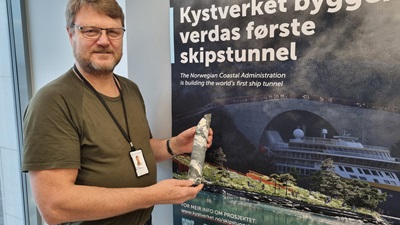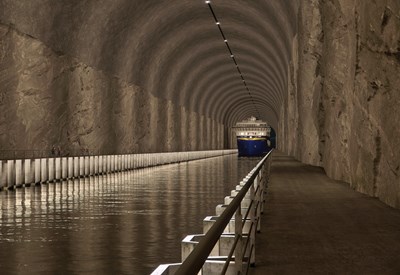Updated 1 February:
A significant aspect of the ship tunnel project revolves around reducing risk, uncertainty, and consequently reducing costs. The core drilling that has been ongoing in Kjøde since the summer of 2023 is now completed. There has been technical challenges and poor progress for some time, so we have decided to stop. The drilling has provided valuable information about the quality of the rock and other documentation that will be useful for the contractor who will operate the tunnel.
This is the second time that the Norwegian Coastal Administration is conducting core drilling to examine the rock quality in the route of the Stad ship tunnel.
- We do this to have better control over the rock quality and ground conditions, which are central elements of risk and uncertainty in the project, says construction manager for the Stad ship tunnel project, Per Åge Havnegjerde.
The drilling is carried out from the Kjøde side, where a drilling rig is set up and entered into the mountain just above the county road.
- Our goal was to drill 1050 meters into the mountain to achieve a complete infiltration of the ship tunnel route. The remaining 650 meters has already been documented through drilling from the Moldefjord side. According to the plan, we should have reached our goal of 1050 meters these days, but due to challenges along the way, there have been some delays, says construction manager Per Åge Havnegjerde.
A lot of water!
The biggest challenges the Norwegian Coastal Administration has faced involve significant water infiltration in the borehole, with relatively high water pressure.
- When encountering water in such quantities, the water must be stopped through the injection of cement. The cement needs time to cure before the drilling can resume. Often, the process has to be repeated to reduce the water volume to an acceptable level for further operations. There have also been operational challenges due to equipment fractures, such as rod breakages several hundred meters inside. It is self-evident that this creates halts in production, leading to further delays, says Havnegjerde.
- How far into the mountain have you managed to drill?
- We have reached just over 500 meters into the route. We are surprised that we are still struggling with significant water infiltration, 5-600 liters a minute at the most, with a pressure of over 20 bar, says Havnegjerde.
Havnegjerde explains that some water in the route from Kjøde was expected, but the professional percepton was that this would decrease further into the mountain. The fact that there is still so much water, 500 meters into the mountain, is a surprise and important knowledge to consider in the further planning of the ship tunnel.
Quality rock
- What about the quality of the rock?
- We have encountered some weak zones and a few minor zones with clay. The clay zones have been analyzed, and it is concluded that it is not expansive clay, which could have given us some challenges. The rock is of good quality, with normal fracture formations, says Havnegjerde.
- The rock type on the core samples is primarily various types of gneiss, with inclusions of quartz and other rocks. In other words, it is typical Norwegian mountain rock, says Havnegjerde.
The rock samples are stored and being analyzed
The core samples have a minimum diameter of 45 milimeters. Once the cores are extracted, they are carefully labelled and placed in boxes. These boxes are transported to the Norwegian Coastal Administration’s warehouse at Nørve in Ålesund. There, the samples are “logged”. This means that geologists go through the material, logging details such as rock type, fracture patterns and weaknesses.
- We do this so that we, as the project owner, and the contractor who will be operating the tunnel, can get an idea of the challenges we may encounter on our way through the rock. This includes aspects such as fracture patterns, water infiltration, weak zones, load-bearing capacity of the rock, and more.
- Even though drilling and the rock samples provide good indications and valuable information, this is from a tiny piece of a big tunnel which has a cross-section of approximately 1700 m2. Therefore, there is no definite answer to what we might encounter inside the mountain, says Havnegjerde.
Considering further progress
- What happens now? Is there hope of reaching the goal of drilling 1050 meters into the mountain from Kjøde?
- In the current phase, we are experiencing very poor progress, and at the same time, we are approaching the influence zone of a mountain lake, Skumdalsvatnet. This is slightly to the side of the tunnel route, but we want to make sure that it has an underlying fracture pattern that could lead to drainage in the tunnel. To bypass this zone, we need to drill approximately 650 meters in, so that becomes the first interim goal. We have decided to continue drilling until mid-January before reassessing whether it is worth pursuing the goals we have set, says Per Åge Havnegjerde at the Norwegian Coastal Administration.

